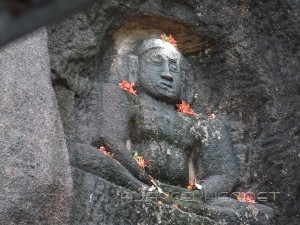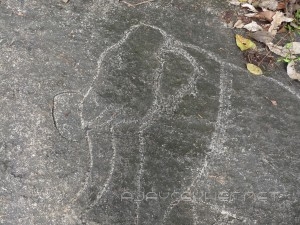Kallil: The Last Surviving Relic of Jainism in Central Kerala

The huge granite structure that houses the shrine
Kallil is a rock-cut temple in central Kerala. It is located a few miles east of Perumbavur in Ernakulam district near Odakali. According to historians like
V V K Valath and P K Gopalakrishnan who have done extensive field studies and archival research in the local history of Ernakulam district it was a Jain temple till the7th or 8th century. The early 20th century commentators have also pointed out the Jain ancestry of the Kallil Pisharady.

Thirthankara image on the mantle
In the ancient Tamilakam Adikal denoted a Jain sage as in Ilanko Adikal the legendary Jain saint (who was the brother of Cheran Chenguttuvan the Chera emperor), who composed
The Silapathikaram the Tamil Sramana epic at (Thrikana)Mathilakam, a few miles west of Kallil near the coast and north of Kodungallur also known as the ancient port of Vanchi or Muziris. It can be reasonably assumed that this rock structure was converted into a Hindu temple after the onslaught of Brahmanism that wiped out Buddhist and Jain cultures from Kerala in the seventh, eighth and ninth centuries through coveted royal patronage and usurpation. The historians record that the idols of Mahavira, Parswanatha and Padmavathi Devi were found from the temple. We can still see the relief of the Jaina Thirthankara on the rock surface above the front opening.

Elephant Icon a Jain Mudra
The cave shrine is housed on top of a small hillock. the top of the shrine is covered naturally by a huge granite rock. There are also images of Naga deities in front of the shrine. Now the image of the Devi is worshiped as a Hindu godess. There is also a rock carving or shallow etching of an elephant image at the back of the shrine, which again is a confirmed Jain icon or Mudra.There are also ancient ponds and tanks that offer clear drinking water nearby. The mineral water springs also confirm the fact that this was an ancient Jain Thirtha or forest cave shrine with a mineral spring that attracted devotees from far and near. We have similar relics of Jain temples in Wayanad in Sulthan Bathery and Mananthavady. In Palghat a Jain Basti still survives and a few families too. the place is called Jaina Medu. But these regions are close to the Karnataka plateau and are exceptions in the cultural geography and history of Kerala.






1 കമന്റുകള്:
jainisavum budhisavum poypoya nalla naalukalute smaranakalunarthunnu.
Post a Comment